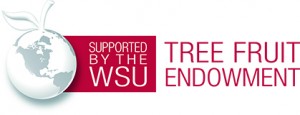NEWS

Summary of WSU session on cold weather effects on pollination, fruit set, and hardiness in apples and cherries.
On April 12, 2022, Matthew Whiting, Professor in the Horticulture Department, and Bernardita Sallato, Tree Fruit Extension Specialist, at Washington State University, hosted a meeting to bring the tree fruit industry together and discuss challenges…

What does the X-disease/Little Cherry Disease Test Results Numbers Means in Terms of Disease Progression?
Summary by Corina Serban, WSU Extension, Scott Harper, WSU Plant Pathology. May 3, 2022. Updated June 2, 2023. The little cherry and X-disease outbreak has become a singular threat to the PNW cherry industry, causing…
Effective Pollination Period and Parentage Effect on Pollen Tube Growth in Apple
Flower receptivity is a limiting factor for the fertilization of several tree fruit. The effective pollination period (EPP) can be used to determine flower longevity and identify limiting factors by assessing stigmatic receptivity, pollen tube…
Microtensiometers: a new tool to monitor your apple trees for deciding when and how much to irrigate
Microtensiometers are sensors that continuously monitor tree water status with potential to be used for growers to help in making irrigation decisions.
Microtensiómetros: Una nueva herramienta para monitorear sus manzanos y decidir cuándo y cuánto regar
Los microtensiómetros son sensores que se instalan en el tronco del arbol y monitorean continuamente el estatus hídrico de la planta. Estos sensores tienen gran potencial en la toma de decisiones acerca del riego.
Managing your crop load in the craziness of Spring 2022
Chemical thinning and crop load management is difficult enough in a normal season, but what in the heck should we do this year? Here are some thoughts and resources that may be helpful.
Cold weather can be tough for trees and for bees. Strong colonies and lots of them is a good place to start
Cold temperatures keep bees from flying. This topic of bee flight and temperature comes up a lot. Almost everything I read says bumble bees and blue orchard bees will forage at lower temperatures than honey…

Nutrient Management in Sweet Cherries
In perennial fruit trees, most nutrient uptake occurs between bloom and rapid vegetative growth. Sweet cherry root growth starts when soil temperatures reach approximately 59 F during spring, usually after bloom in Washington soils. In…

Blue orchard bees
As early spring bees, BOBs are better adapted for flying under poor weather conditions than most other bees. BOBs forage and pollinate under overcast skies and at temperatures as low as 54°F (12C), when other…
How to Effectively Manage Codling Moth
Without any intervention, codling moth numbers increase about four-fold from generation to generation. Therefore, targeting the first generation is important to reset the population size to a minimum. Control measures for subsequent generations can be…
Using the Pear Psylla Phenology Model for “soft” (IPM) Programs
Using the pear psylla phenology model in the WSU Decision Aid System can increase the effectiveness of a pear psylla IPM program (i.e., a “soft” program). IPM programs keep pear psylla below economic thresholds using…
2022 Fresh and Processed Pear Committee Research Grant Awards
Based on the recommendations of the Pear Research Subcommittee (PRSC), the Fresh and Processed Pear Committees (FPC & PPC) approved $255,575 to fund five (5) new pear projects in March 2022.
Cold wet weather favorable for cherry blossom blast
Written by Dr. Youfu “Frank” Zhao, Professor & Endowed Chair in Bacterial diseases, WSU-IAREC, May 3, 2022 Bacterial canker risks we experienced in April 2022 and what growers should be looking for to assess damage…

Resources for Little Cherry & X-disease Scouting and Sampling 2022
Multiple resources are available for scouting and sampling of X-disease and Little Cherry disease during the 2022 season.
LATEST VIDEOS
Assessing Cold Damage – a Demonstration
This is the last of a four-part series from the sweet cherry cold hardiness webinar held on Oct 29, 2020. In this video, Assessing cold damage, Dr. Matthew Whiting, WSU professor, demonstrates how to assess…
How to check for apple bud damage on the tree
Looking for apple bud damage? Watch as Washington State University’s Matthew Whiting shows how to quickly cut and evaluate apple buds on the tree and identify flower part damage
Cómo verificar si hay daños en la yema de la manzana en el árbol
¿Busca daños en los brotes de manzana? Observe cómo Bernardita Sallato, de la Universidad Estatal de Washington, muestra cómo cortar y evaluar rápidamente los capullos de manzana en el árbol e identificar los daños en…

Enfermedad de la cereza pequeña en cerezos
Bernardita Sallato comparte información respecto a la enfermedad de la cereza pequeña, síntomas para su identificación, medidas de prevención y control de vectores.

Symptoms of X-disease Phytoplasma in Stone Fruit
X-disease in peaches, plums and nectarines causes yellow leaves, shot hole and small deformed fruit.

Scouting and Sampling for Little Cherry Disease
Tips on scouting and sampling for X-disease and Little cherry disease which cause small, pale unmarketable fruit in cherries.
OPPORTUNITIES
WORKSHOPS AND TRAININGS
Queen Rearing and Bee Breeding Workshop
June 22 – June 23 Ready to take beekeeping to the next level? For those of you who already have a working foundation in beekeeping, the WSU bee team is offering an event to introduce you to…
Field Tour Sign Up: Growing Your Farm to Make Conservation Profitable
Join your local NCW conservation districts on a field tour of a local orchard and vineyard and learn about conservation practices that could potentially reduce management costs.
PUBLICATIONS
Sweet Cherries
L. Long, G. Lang & C. Kaiser Dec 2020. This new book provides comprehensive coverage of the history, genetic improvements, production physiology of growth and cropping, orchard establishment and management, and harvest considerations for sustainable…
EVENTS
Airblast Spray Application and Modeling Conference
May 16 | Webinar
TEAM
Karen Lewis
Tianna DuPont
Dani Gray
Gwen Hoheisel
Marcella Magby
Manoella Mendoza
Claire Murphy
Bernardita Sallato
Tory Schmidt
Corina Serban
EDITOR
The May 2022 edition of Fruit Matters was edited by Corina F. Serban, WSU Extension.

